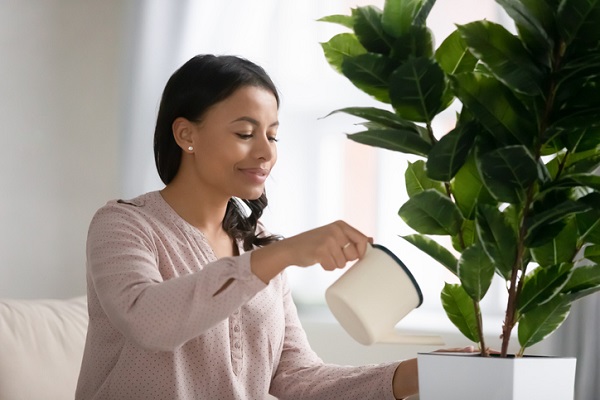Bringing the outdoors in can be as easy as picking the right house plant. Indoor plants are great for improving the look of your home. Plus, they provide health benefits, like recycling the air and providing extra humidity. From succulents and snake plants to bright light and low light, there are so many options. Today, we’ll show you some eye-catching house plants that are fairly low maintenance and can help you bring the outdoors in.
Staghorn fern (Platycerium bifurcatum)
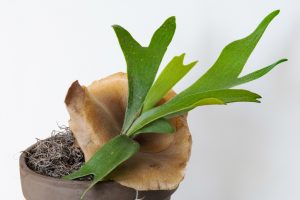
Laden with wide, imposing leaves, staghorn ferns are great eye catchers. You can usually find staghorn ferns (named for their leaves, which look like the horns of a stag) in hanging baskets or mounted on boards. That’s because they don’t naturally grow in soil—instead, they take nutrients from the air. So, if you like the idea of staghorn ferns, make sure you can hang it in a basket or on a board.
Staghorn ferns can be a bit challenging to take care of if you’ve never had one before. They require bright indirect sunlight, so a north-facing window may be best for them. To water this plant, you’ll need to either mist the roots and leaves regularly or fully submerge the roots in water for about 20 minutes once a week.
Swiss cheese plant (Monstera adansonii)
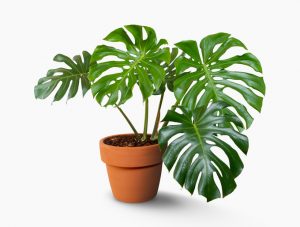
Another popular indoor plant, the Swiss cheese plant is named for the distinct holes in its leaves. Swiss cheese plants are interesting in that when given the right conditions, they can be viney plants. You can help it crawl by putting a stick in the pot you plant it in.
Swiss cheese plants like bright indirect light and lots of humidity. Avoid putting it in direct sunlight, because it burns easily. They like peaty, acidic soil with lots of drainage, too. When watering, make sure the soil stays moist but not drenched. If the soil feels dry to the touch, it’s time to water.
One downside of Swiss cheese plants is that they’re poisonous to dogs and cats. While it likely won’t kill a pet, it can make them sick. So, keep it up high and out of reach.
Snake plant (Dracaena trifasciata)
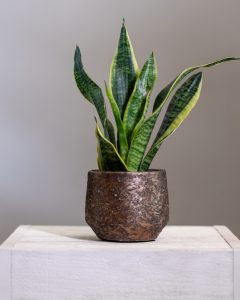
Snake plants are excellent for creating the illusion of height in a room. Even better, they’re really good at filtering air. It’s little wonder why these plants are popular in bedrooms and front rooms.
Dracaena likes warmer temperatures, between 70°F and 90°F. When potting this plant, use loose, well-draining soil. You can even use succulent soil for this plant. It’s fairly easy to water, as you only need to water it when the soil dries out. Just be sure not to let the soil get soggy, or root rot will set in.
Like other plants on this list, this plant is toxic to cats and dogs. While they aren’t usually fatal, they can cause upset stomach, vomiting, and diarrhea.
One final, more positive note about this indoor plant is that sometimes, they can produce white flowers that resemble lilies and smell nice. However, this is extremely rare for this indoor plant. So if you see it, take a picture!
Fiddle leaf fig (Ficus lyrata)
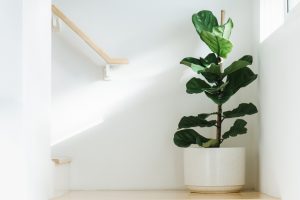
If you want an indoor tree, you’ll love the fiddle leaf fig. Its huge leaves are eye catching, and the ficus can grow tall, accentuating the height of the room.
This beautiful plant is the most difficult to care for on this list. Fortunately, it’s not impossible.
First, fiddle leaf figs need a ton of direct sunlight. Large, south-facing windows are ideal for this plant, but you also need to make sure you don’t let the leaves burn. You can protect it with a thin, sheer curtain if the leaves begin to burn.
Second, this indoor plant likes moist soil and lots of humidity. To know when to water, use one of two signs.
- The soil is dry two inches deep.
- The leaves look floppy.
Finally, it’s extremely important to keep this indoor plant away from vents and drafts. It’s more sensitive than others to environmental changes.
Be cautious with this plant around dogs and cats. It’s toxic to them.
Painted-leaf begonia (Rex begonia)
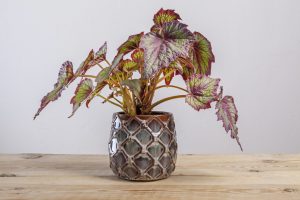
Despite this plant’s exotic appearance, painted-leaf begonias are quite easy to grow. Since it’s a relatively small houseplant, painted-leaf begonias are perfect for tabletops and desks where its wildly colorful foliage creates a compelling contrast against other house plants. To make your painted-leaf begonia even more eye catching, you can dress it up by growing it in a pot that complements colors in the foliage, whether it’s red, pink, purple, or even black.
Painted-leaf begonias like bright indirect light. When watering, wait until the top of the soil has dried out completely before watering again, usually about once a week. They generally do well in moderate temperatures, between 65°F and 75°F.
Like the Swiss cheese plant, this plant is poisonous to pets. Be sure your pets can’t reach this house plant, as it can cause kidney failure if ingested.
Frizzle sizzle (Albuca spiralis)
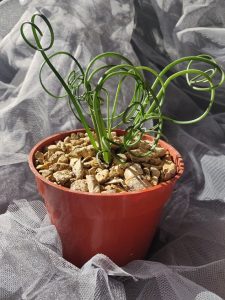
The frizzle sizzle is a fun succulent that’s super easy to care for. A desert plant, the frizzle sizzle’s leaves curl as a way to retain water in the extremely dry environment it lives in.
Unlike the other plants on this list, the frizzle sizzle’s growing season is in the winter, making it a perfect complement to your other plants.
Frizzle sizzles are very easy to care for. They require loose, sandy soil with good drainage to prevent root rot. During the winter, you should water them about once a week, just enough to keep the soil moist. In the summer, which is their dormant season, you can cut back on watering them to once a month.
Frizzle sizzles thrive in full sun, so keeping them on a desk or table in a south-facing room can be helpful.
In late winter/early spring, you may notice a stalk begin to climb up the middle. That’s the plant’s flower stalk. As it grows, you may notice that your spiral leaves will begin turning red at the tips. That’s because the flower stalk is taking energy to produce the flower. If you prefer having curled leaves, simply snip the flower stalk.
Like other plants, you should keep dogs and cats away from this indoor plant. While rarely fatal, it can cause an upset stomach.
2-10 HBW offers the most comprehensive home warranty coverage for homeowners. Let us help you protect your home.
Related content
5 Tips for Planning Your Home Garden


